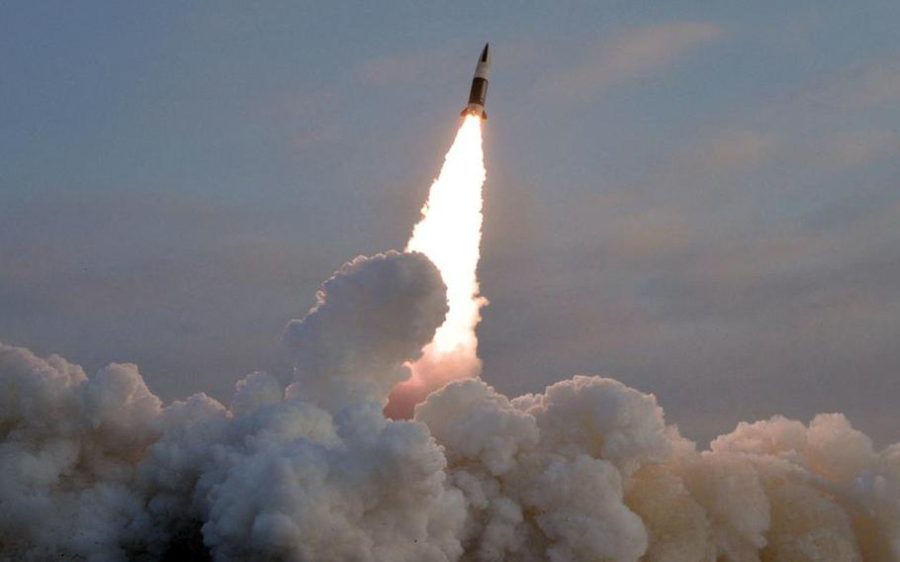North Korea Launches Ballistic Missiles Over Japan
The Democratic People’s Republic of Korea (DPRK or North Korea, for short) recaptured national attention earlier this month by making a surprisingly bold move: on October 3rd, they launched multiple ballistic missiles over Japan, which responded with a state of panic as residents were ordered to take shelter under concrete structures while ballistic missile sirens wailed. The intermediate-range ballistic missile flew over northern Japan before crashing into the Sea of Japan, marking the first time in five years that North Korea has fired missiles over Japan. According to the Defense Ministry of Japan, another two short-range missiles landed outside of Japan’s economic exclusion zone on Thursday, October 6th.
According to Yasukazu Hamada, Japan’s defense minister, the first missile was launched at 6 AM and traveled about 217 miles, reaching a maximum altitude of about 62 miles. The second missile, which launched at 6:15 AM, flew close to 500 miles and as high as 31 miles.
This drill by North Korea was conducted shortly after U.S and South Korean forces fired four surface-to-surface missiles off the east coast of South Korea. Analysts have said that North Korea appears to be intensifying its missile-testing program in advance of midterm elections in the United States, and in response to an American aircraft carrier, USS Ronald Reagan, sailing in the waters between Japan and the Korean Peninsula for the first time in five years when it was assigned to joint military exercises last month.
Other sources are convinced that North Korea launched the missiles as a way of showing off their “superior firepower,” but this is only speculation; similarly, there are sources that theorize that the DPRK uses their missiles as a way to flaunt that their technology actually works, since one of the four US missiles failed to launch and caused a fire. DPRK Supreme Leader Kim Jong Un is certainly talking the talk, but can he walk the walk?
On Thursday, October 6th, when the short-range missiles struck outside of Japan, Kim said that “our nuclear combat forces … proved again their full preparedness for actual war to bring the enemies under their control,” according to the KCNA (Korean Central News Agency). Similarly, last month, Kim declared North Korea an “irreversible” nuclear power and revised its laws, allowing it to use nuclear weapons pre-emptively, whereas previous DPRK policy had been to only use such weapons in response to an attack. This new revision of their laws makes North Korea an even bigger threat to South Korea, as well as the rest of the world.
Unsurprisingly, this resulted in a diplomatic intervention by the United Nations (UN), whose Secretary-General, António Guterres, urged North Korean leadership to immediately cease and desist from any further destabilization of the relationship with South Korea, furthermore asking that the DPRK resume dialogue towards the denuclearization of the Korean Peninsula. The most nerve-racking thing said by North Korea so far is that they claimed to have successfully simulated hitting South Korea’s military bases, ports and airports, and said the launches were a warning to US and South Korea. This is not the first time North Korea has created tensions in the DPRK and the U.S; in fact, North Korea has been on a broad trajectory of qualitatively refining and quantitatively expanding its nuclear capabilities since the spring of 2019. That’s right—they have been making nuclear missiles since 2019!
According to North Korean defense officials, in 2020 they developed a long-range missile that could reach all of North America, while Kim spent a while earlier taunting former president Donald J. Trump, saying that he has a button on his desk that could obliterate the United States. Trump quickly responded, saying that he has a bigger button that “actually works.” As expected. Trump was making it clear that America will not be trifled with in this area. How the US will respond to the missiles more generally is still unknown, but whatever it may be, they will surely need to maintain a close eye on the Korean Peninsula, to manage issues with further “incidents.”
